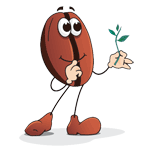A year in the life of a jamaican Blue Mountain coffee grower (Introduction part 1)August: Here we are at the start of the new coffee season. I moved into this little bit of Jamaican paradise on August 1st, 2005, and use the date for my accounting of the "coffee year": and what a most convenient date it turns out to be. The last of the coffee from the past season, is just awaiting final processing, hulling and roasting; and we now have a couple of months to get more of the land cleared, the fertilizing and pruning done, hoping and praying that we will be spared a bad hurricane this year. We have had a really good "flowering" this year, first flowering was back in early February, before we even completed the picking; with several rainy periods ( the coffee only flowers, just after good rains, and in a drought, like this year, ( worst drought for 15 years, on the Island ) needs only a short, but heavy "shower", to bring on the flowers: this year, several flowerings, hinting at a good crop, this season! Hurricanes allowing!! As I am writing this, there is one full hurricane ( Danielle, far left on the satellite image, below ), one tropical storm, about to develop into a hurricane ( Earl ), and a third tropical depression, just off the coast of Africa, forecast to develop into hurricane Fiona, in a few days time: with another four tropical waves developing over the African mainland; any or all of which could develop in to hurricanes August and September are the height of the hurricane season, and this year is forecast to be a VERY bad one! It is the time of year that we have to check out several weather sites, to get the maximum notice of a hurricane that might affect Jamaica ( but more about hurricanes in a later episode, assuming we survive!! ). This image was taken Wednesday ( Aug 25th ) so everything will have moved a bit further west.
This little bit of paradise, 4.22 acres, house, garden, and 4 acres of it in coffee: is located almost in the heart of the JBM growing area: if you can get hold of a map of Jamaica, we are at Silver Hill Gap: exactly at the centre of a line drawn from Harbour View, the most easterly end of Kingston Harbour; and ( almost due North ) to Buff Bay, on the North coast. To help you locate the exact position, the parish boundary ( marked on all maps ) runs about 50 feet to the south east of the house. Towering over the plantation, is John Crow Peak, at 5,750 feet, 5th highest of the Blue Mountain, peaks: and they really are aptly named the "blue" mountains; as that is the colour they appear!! There have been occasional reports of a frost appearing, briefly, on the top of Blue Mountain Peak ( 7,402 feet ) and a small hail storm, some years ago, warranted a report in the local newspapers!! The plantation is on the ridge that separates the two valleys ( Gap is the local name for a "pass" ) on either side of our ridge, two rivers, running in opposite directions, to the North, the Buff river, ( where we have a most wonderful view, for many miles down the valley, almost to the Caribbean sea ); and from the other side of the ridge, the Yallahs river, flowing to the South, down past the Mavis Bank coffee factory, and on to Yallahs, on the South Coast, well east of Kingston. Before I wander off into my "coffee growers diary" and general ramblings about the local coffee industry, and other "happenings": I am sure that you will want a little more, in the way of putting all that follows, into some context:- I am a "pure" Englishman, taken early retirement, and now find myself with a beautiful retirement house, set in a most spectacular part of the Jamaican Blue Mountains, the house "came" with some 4 acres, of very neglected, and run-down coffee: which is now in the process of serious "rehabilitation"; we are planting a load more coffee, "Geisha", when we can get the seedlings, as it is a variety that not only makes superb coffee, but is fast growing, bears very well, and produces a high proportion of "A" grade, sized, beans. Full details of the quality criteria for JBM beans in a later episode. I decided to retire to Jamaica, not with the slightest intention of growing coffee, but when I first saw this house, that was it!! and the coffee plantation, came as a total bonus!! Over these few years, as well as the coffee, and all the fruit trees, we have some bee hives ( and planning to put in several more ) a small collection of some of the indigenous Orchid species, and the garden planted with as many of the local, "interesting" plants, as we can find. Just weeding the garden is almost a full time job! How can I possibly describe the taste of my very own coffee: the very first cup that I drank: picked with my own hands, and apart from using the 16 inch office fan to winnow the dried and hulled beans, ONLY my own hands processed the coffee beans ( and the electric coffee grinder ) the beans were roasted in a "Dutch pot", over a wood "camp" fire: that first time, as the nectar hit the taste buds: just NO words to describe it!! Never had I tasted a coffee with so many subtleties, such balance, and long lasting palate: I still keep a jar of "powdered coffee" ( that revolting instant rubbish ) and have to have the occasional taste of it: just to remind my palate what I used to drink, and think was coffee. Will give you a detailed description of the processing, in a later episode. Apologies for that short break in "transmission": another minor emergency to get fixed: the taps had run dry, no water! Dig out the water pump, check it, connect the hoses, fire it up, and replace the water. Our water system uses collected rain water, collected from the roof, and stored in a big underground tank, we then have to pump it up to the storage tanks above the house, from where we can pipe it to the house: the water pressure is not very high ( the upstairs shower is almost useless, with a lack of pressure ) but adequate for most daily, purposes. This water is not suitable for cooking or drinking: our drinking water is collected in 15 litre containers, from one of the several local springs, and it does make excellent coffee! This evening, the finale of another perfect day!! Warm and sunny, had a good rain shower, badly needed by the coffee, as well as all the garden plants: late evening now, a most pleasant 70F, with the most gentle of breezes, that just keeps the air moving through the house; the wonderful scent of the [ Cestrum nocturnis ] "night Jasmine", gently wafting through the house, on the gentle air movement. Was another nice "tropical" day, up here it rarely reaches the mid 80'sF, hovering in the lower part: at the coldest time of the year, mid February, and it gets quite chilly, occasionally dropping down as low as 55F, overnight, perfect climate, for the coffee. Down in Kingston: much hotter ( mid 90'sF ) and even on the coolest of winter nights, rarely gets as low as 65F, and the higher humidity, upping the "heat index", considerably! From here we are only 8 miles from the centre of Kingston ( straight line! ) but, over 25 miles, by road: up over the mountains, ( a little over 4,000 feet at the "pass", before the long drop down ) takes over 90 minutes to the centre of Kingston, due to the awful roads!! A good average speed, for the weekly shopping trip, is only 18mph!! The best of our coffee is growing on a North West slope, which gives it full sunlight, when the sun is to the north of Jamaica ( for a few weeks, either side of midsummer's day ), just when the coffee bushes need the maximum amount of sunlight, to get plenty of "nutriments" into the small, developing, coffee beans: a combination of the mists, and the slope, limits the sun, through late summer, and into the Autumn, and Winter, and slows down the ripening of the coffee berries, which improves the flavour, the best of my coffee, is that which I pick in March, the last full picking, before we get to the left-overs. I just wish I had the writing skills of someone like Charles Dickens to be able to give you, at least, a general impression of what I have, here. I have well and truly lost count of the hours I have spent ( cup of MY coffee in hand ) and just watched the "views" down the valley; an ever changing scene as the sun moves across the sky, and the light changes direction. The world famous Blue Mountain mists, really something to see: late morning and the first traces of the mist start to creep up the valley, at times it looks as though it is a living thing, a tendril here, another there, wrapping around the trees, as it creeps up the slope to my plantation. It slowly envelopes us, and if heavy enough, will produce a short rain shower, before slowly fading away as the sun starts to go down. On an evening where it is slow to retreat, and just a little remains, the setting sun illuminates the mists, and it reflects off the white clouds lingering above the peaks above us, the very air itself appears to glow "golden", slowly darkening to pink, and then through red and a few moments of purple. Other evenings, when the mist is across the far side of the valley, as the sun drops below the mountains, great sunbeams, illuminate parts of the mists, producing the most marvellous effects of light and shade. AND every last one of the hundreds of photos I have taken, are "useless"!!! it is something that HAS to be seen, eyeballed, for yourself. To be continued here ... Robin Plough, friend of www.coffee4dummies.com For questions about JBM, mail to: Этот e-mail адрес защищен от спам-ботов, для его просмотра у Вас должен быть включен Javascript |
Growing: Part 1
Growing: Part 1


 Very early this year, but we are getting reports that w-a-y down the valley ( Robustica coffee ) the lowland coffee is already cropping, a good few weeks earlier than usual; up here, at 3,500 feet ( a friend with one of those GPS "toys", well, he is a gadget freak!! just HAD to flash it off, and measured my balcony, at almost the highest point of the plantation, to be 3,523 feet in elevation: wow!! was that interesting!!, I had already worked it out from the map, and I was only some 17 feet out from his GPS!! having put it at 3,540 feet ).
Very early this year, but we are getting reports that w-a-y down the valley ( Robustica coffee ) the lowland coffee is already cropping, a good few weeks earlier than usual; up here, at 3,500 feet ( a friend with one of those GPS "toys", well, he is a gadget freak!! just HAD to flash it off, and measured my balcony, at almost the highest point of the plantation, to be 3,523 feet in elevation: wow!! was that interesting!!, I had already worked it out from the map, and I was only some 17 feet out from his GPS!! having put it at 3,540 feet ).


